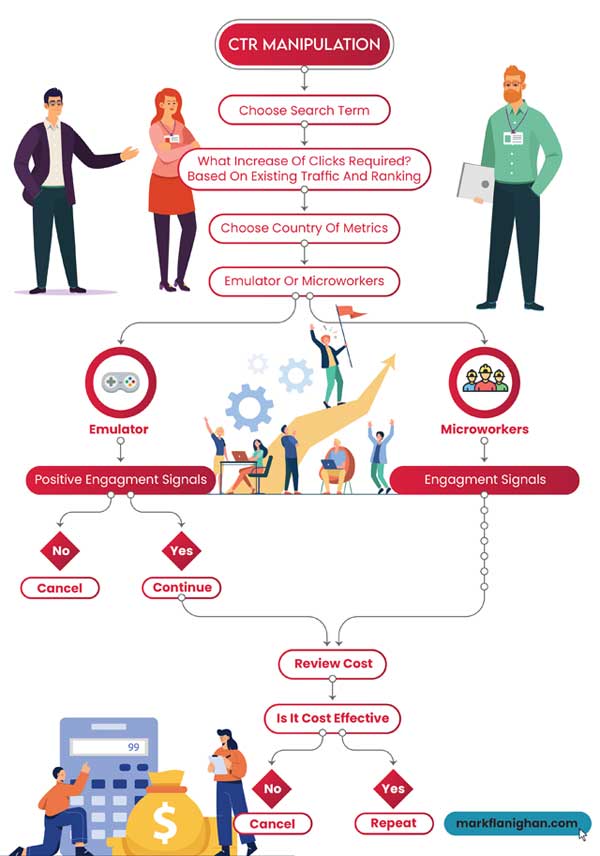Discovering the Relationship In Between CTR Control Solutions and User Habits
In the world of digital advertising and marketing, the impact of click-through price (CTR) manipulation solutions on individual actions remains a complicated and appealing subject. As on the internet platforms increasingly rely upon CTR metrics to measure the success of content, items, and services, comprehending how these controlled prices influence customer involvement and decision-making procedures is paramount. The interaction in between CTR control and individual habits elevates questions regarding authenticity, credibility, and the ethical implications of such methods. By studying the detailed relationship between CTR adjustment services and user habits, intriguing insights arise that may improve our understanding of electronic marketing methods and their results on consumers.
Influence of CTR Manipulation on Actions
Evaluating the influence of Click-Through Rate (CTR) control on customer habits discloses vital insights right into the characteristics of online interaction. CTR control entails artificially pumping up the number of clicks on a specific link or promotion to trick users and search engines. This technique can bring about a distorted perception of a webpage's appeal or relevance, eventually affecting individual behavior.

In addition, CTR control can skew the data utilized by formulas to customize user experiences. This can result in customers being served web content that does not align with their preferences or passions, eventually resulting in a decrease in user complete satisfaction and engagement. Recognizing the influence of CTR manipulation on customer habits is important for keeping transparency and rely on online interactions.
User Interaction With Manipulated CTR
Individual involvement with controlled CTR data typically brings about skewed perceptions of on the internet web content appeal and relevance. When individuals engage with web content based upon synthetically inflated Click-Through Fees (CTR), they may believe that specific details, products, or services are more preferred or reliable than they in fact are. This can result in customers making decisions based upon deceptive information, bring about possibly undesirable end results.
Interaction metrics like likes, shares, comments, and time invested in a web page are often affected by CTR control. Users might be a lot more inclined to involve with content that shows up to have higher involvement rates, additionally bolstering the cycle of manipulated assumptions. Consequently, material creators and advertisers may focus on generating material that generates high CTR instead of concentrating on producing really valuable and appropriate product.

Emotional Impacts of CTR Manipulation

Furthermore, the emotional results of CTR adjustment can additionally materialize in transformed decision-making processes. Customers may be a lot more inclined to click content exclusively based upon its regarded appeal, as opposed to its real value or significance to their requirements. This behavioral change can lead to a superficial involvement with on the internet content, where customers might overlook high-quality yet less preferred offerings for those with artificially enhanced CTRs.
In significance, the mental implications of CTR control highlight the importance of keeping transparency and credibility in online interactions to cultivate authentic individual involvement and depend on.
Honest Considerations in CTR Adjustment
CTR manipulation raises problems concerning deceiving individuals, misshaping data analytics, and compromising the credibility of online content. By artificially pumping up CTR, customers might be misled right into clicking on web links or advertisements they would not have picked or else, leading to an insincere online experience.
One more honest aspect to ponder is the justness of controling CTR to get an unfair benefit over rivals. Involving in such techniques not only breaches principles of justice but additionally threatens the trust that customers position in on the internet platforms. It is essential for businesses and electronic marketing experts to promote honest standards in their techniques to make sure transparency, trustworthiness, and long-term sustainability in the on-line environment.
Effects for Digital Advertising
With the enhancing dependence on electronic platforms for advertising purposes, the technique of manipulating click-through prices (CTR) postures considerable implications for the performance and integrity of digital marketing methods. CTR manipulation can cause manipulated information analytics, deceiving marketing experts into thinking that their campaigns are carrying out better than they in fact are. This can lead to misallocation of sources, with companies investing in underperforming approaches based on falsified CTRs. When customers realize that CTRs have actually been controlled, it can deteriorate trust fund in the why not try this out brand, leading to long-term unfavorable repercussions for consumer commitment and brand name track record.
Additionally, the use of CTR control services can produce an unfair competitive landscape, where business that engage in such practices gain a synthetic advantage over those that comply with honest advertising requirements. This can stifle development and creativity in digital advertising and marketing, as success ends up being even more concerning manipulation tactics than supplying real value to customers. Eventually, the ramifications of CTR control for electronic advertising prolong beyond short-term gains, influencing the general sustainability and integrity of advertising initiatives see in the electronic world.
Conclusion
In verdict, the partnership between CTR adjustment solutions and individual behavior is intricate and diverse. The impact of CTR adjustment on habits, customer interaction with manipulated CTR, emotional impacts, moral considerations, and implications for electronic marketing all contribute fit this partnership. Comprehending these characteristics is vital for marketing experts and researchers alike in order to browse the ethical implications and optimize the effectiveness of their electronic advertising and marketing methods.